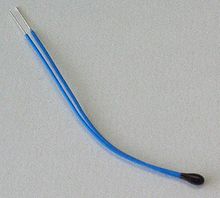Thermistor
A thermistor , NTC resistor or NTC thermistor ( English Negative Temperature Coefficient Thermistor ) is a temperature-dependent resistor that belongs to the group of thermistors . Its essential property is a negative temperature coefficient and conducts electrical current better at high temperatures than at low temperatures.
General
Pure semiconductor materials , some compound semiconductors and various metallic alloys show thermoconductive behavior . NTC resistors made of metal oxides usually consist of pressed and sintered metal oxides of manganese , nickel , cobalt , iron , copper or titanium mixed with binders . In the past, thermistors were also made of uranium dioxide (Urdox resistors).
NTCs serve as temperature sensors or as inrush current limiters . Wires made of a platinum alloy or nickel / iron are used to make contact with the typically pearl-shaped temperature sensor NTCs . They combine with the NTC material when the pearl is sintered . Other designs are disks, SMD chips or cylindrical shapes - they are contacted by means of metallized surfaces.
Applications
NTC thermistors are used, among other things, as temperature sensors such as resistance thermometers or for temperature compensation in electronic circuits. In motor vehicles, thermistors z. B. used as a motor temperature sensor. Modern NTCs only have low tolerances. In the case of high accuracy requirements, however, these sensors are not simply exchangeable, even with the same nominal value, due to the specimen variance without re-recording the characteristic curve ( calibration ) or adjustment of the device used.
NTC thermistors are also used to limit inrush currents. A thermistor in the supply line of an electrical device is cold before it is switched on, therefore conducts poorly and reduces the inrush current when it is switched on . After switching on, it heats up due to the flow of current and loses its high initial resistance, which means that the electrical device reaches its full electrical output.
Basics
NTC thermistors are available with a rather flat, non-linear characteristic curve for measuring tasks and with a characteristic curve that is very steep in a certain temperature range for limiting the inrush current. Resistance and characteristic are influenced by the following three manufacturing parameters:
- Mixing ratio of oxides of different crystal structure
- Doping the metal oxides
- Stoichiometric deviations of the oxides - variable by the firing atmosphere (oxygen content) and the cooling rate
Thermally easily activated flaws arise, so that the power line increases sharply with temperature.
The following applies approximately:
With
The individual symbols stand for the following quantities :
- ... resistance to temperature
- ... nominal resistance at nominal temperature
- ... absolute operating temperature
- ... nominal temperature (mostly 25 ° C, i.e. 298.15 K)
- ... activation energy , adjustable via the band gap of the semiconductor material
- ... Boltzmann constant
- ... Euler's number
is a material constant and, like the nominal resistance, is specified by the manufacturer in the data sheet. It is approximately between 2000 K and 5000 K. is offered in a range over several powers of ten.
A better approximation of the temperature-resistance relationship of an NTC thermistor can be given by the Steinhart-Hart equation :
or as a numerical equation
The numerical value of the resistance must be given as the unit of measurement Ohm, the numerical value of the temperature as the unit Kelvin .
Further characteristics are
- the self-heating coefficient - given in ° C / mW - or the thermal conductivity (dissipation factor) - given in mW / ° C - as a measure of the self-heating due to the current,
- the response time after which a sudden change in the temperature of the material to be measured has been accepted by the sensor at a given percentage, or the cooling time constant for the duration of a partial cooling of the sensor after the power has been switched off.
These characteristics depend on the nature of the material to be measured (air, liquid) and its flow rate.
Web links
- Electronics compendium: NTC thermistors
- NTC thermistor application 1: NTC inrush current limitation with relay bridging (audio amplifier)
- NTC thermistor application 2: NTC inrush current limitation with mains voltage-fed bridging relay
- Software for thermistor calculation at sourceforge.net
Individual evidence
- ↑ Wilfried Meyer: Urdox resistors. Technical use . In: Archive for technical measurement . No. Z117-3, October 1938.
- ↑ data sheets from epcos
- ^ Lothar Michalowsky: New ceramic materials; Page 160f.
- ↑ data sheets (PDF; 7.3 MB). Retrieved December 3, 2016 .
- ↑ data sheets. Retrieved December 8, 2016 .
- ↑ Application Note. (No longer available online.) P. 3 , archived from the original on September 22, 2016 ; Retrieved December 3, 2016 . Info: The archive link was inserted automatically and has not yet been checked. Please check the original and archive link according to the instructions and then remove this notice.
- ↑ Application Note. P. 1 , accessed December 3, 2016 .
- ↑ Application Note. (No longer available online.) P. 3 , formerly in the original ; Retrieved December 3, 2016 . ( Page no longer available , search in web archives ) Info: The link was automatically marked as defective. Please check the link according to the instructions and then remove this notice.















